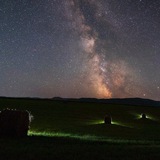
Telegram-канал cosmosx - Космос 🔭
 440
440
Новости, фотографии, статьи о космосе. #Книги #Статьи #Новости Научные журналы: @scientificmagazine

 440
440
Новости, фотографии, статьи о космосе. #Книги #Статьи #Новости Научные журналы: @scientificmagazine

The Horsehead Nebula Region without Stars
Copyright: George Chatzifrantzis
Explanation | Full Source

IC 5146: The Cocoon Nebula
Copyright: David Jenkins
Explanation | Full Source

The Cartwheel Galaxy from Webb
Explanation | Full Source

Full Moon Perseids
Copyright: Juan Carlos Casado
Explanation | Full Source

A Meteor Wind over Tunisia
Copyright: Makrem Larnaout
Explanation | Full Source

Dust Clouds of the Pacman Nebula
Copyright: Douglas J. StrubleFuture World Media
Explanation | Full Source

Meteor before Galaxy
Copyright: Fritz
Helmut Hemmerich
Explanation | Full Source

M13: The Great Globular Cluster in Hercules
Copyright: Joan Josep Isach Cogollos
Explanation | Full Source

A Moon Dressed Like Saturn
Copyright: Francisco Sojuel
Explanation | Full Source

Starburst Galaxy M94 from Hubble
Explanation | Full Source

To Fly Free in Space
2017-12-31
What would it be like to fly free in space? At about 100 meters from the cargo bay of the space shuttle Challenger, Bruce McCandless II was living the dream -- floating farther out than anyone had ever been before. Guided by a Manned Maneuvering Unit (MMU), astronaut McCandless, pictured, was floating free in space. McCandless and fellow NASA astronaut Robert Stewart were the first to experience such an "untethered space walk" during Space Shuttle mission 41-B in 1984. The MMU worked by shooting jets of nitrogen and was used to help deploy and retrieve satellites. With a mass over 140 kilograms, an MMU is heavy on Earth, but, like everything, is weightless when drifting in orbit. The MMU was replaced with the SAFER backpack propulsion unit. Memorial: Astronaut Bruce McCandless II Dies at 80
Full Source

NGC 6888: The Crescent Nebula
2012-08-16
Explanation | Full Source

Jupiter from the Webb Space Telescope
Explanation | Full Source

Maneuvering in Space
2006-05-22
What arm is 17 meters long and sometimes uses humans for fingers? The Canadarm2 aboard the International Space Station (ISS). Canadarm2 has multiple joints and is capable of maneuvering payloads as massive as 116,000 kilograms, equivalent to a fully loaded bus. Canadarm2 is operated by remote control by a human inside the space station. To help with tasks requiring a particularly high level of precision and detail, an astronaut can be anchored to an attached foot constraint. The arm is able propel itself end-over-end around the outside of the space station. Pictured above, astronaut Stephen Robinson rides Canadarm2 during the STS-114 mission of the space shuttle Discovery to the ISS in 2005 August. Space shuttles often deploy their own original version of a robotic arm dubbed Canadarm. Next year, a second robotic arm is scheduled to be deployed on the space station.
Full Source

Tiangong Space Station Transits the Moon
Copyright: Lucy Yunxi Hu
Explanation | Full Source

Saturn: 1993 - 2022
Copyright: Tunc Tezel
Explanation | Full Source

Stargate Milky Way
Copyright: Maxime Oudoux
Explanation | Full Source

The Cygnus Wall of Star Formation
Copyright: Johan Bogaerts
Explanation | Full Source

Perseids and MAGIC
Copyright: Urs Leutenegger
Explanation | Full Source

The Lagoon Nebula without Stars
Copyright: Sameer Dhar
Explanation | Full Source

Curiosity Rover Takes Selfie on Mars
2017-11-20
Yes, but have you ever taken a selfie on Mars? The Curiosity rover on Mars has. This selfie was compiled from many smaller images -- which is why the mechanical arm holding the camera is not visible. (Although its shadow is!) Taken in mid-2015, the featured image shows not only the adventurous rover, but dark layered rocks, the light colored peak of Mount Sharp, and the rusting red sand that pervades Mars. If you look closely, you can even see that a small rock is stuck into one of Curiosity's aging wheels. Now nearing the end of 2017, Curiosity continues to explore the layers of sedimentary rocks it has discovered on Vera Rubin Ridge in order to better understand, generally, the ancient geologic history of Mars and, specifically, why these types of rocks exist there. Now Available: The 2018 APOD Calendar
Full Source

A Beautiful Trifid
Copyright: Vikas Chander
Explanation | Full Source

Halo of the Cat's Eye
Copyright: Bray Falls
Explanation | Full Source

Mountains of Dust in the Carina Nebula
Explanation | Full Source

SOFIA's Southern Lights
Copyright: Ian Griffin
Explanation | Full Source

North Celestial Tree
Copyright: Jeff Dai
Explanation | Full Source

Crepuscular Moon Rays over Denmark
Copyright: Ruslan Merzlyakovastrorms
Explanation | Full Source